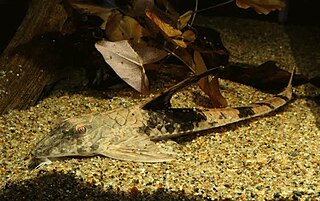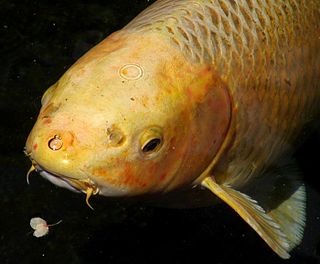
Catfish are a diverse group of ray-finned fish. Named for their prominent barbels, which resemble a cat's whiskers, catfish range in size and behavior from the three largest species alive, the Mekong giant catfish from Southeast Asia, the wels catfish of Eurasia, and the piraíba of South America, to detritivores, and even to a tiny parasitic species commonly called the candiru, Vandellia cirrhosa. Neither the armour-plated types nor the naked types have scales. Despite their name, not all catfish have prominent barbels or "whiskers". Members of the Siluriformes order are defined by features of the skull and swimbladder. Catfish are of considerable commercial importance; many of the larger species are farmed or fished for food. Many of the smaller species, particularly the genus Corydoras, are important in the aquarium hobby. Many catfish are nocturnal, but others are crepuscular or diurnal.

Airbreathing catfish comprise the family Clariidae of the order Siluriformes. Sixteen genera and about 117 species of clariid fishes are described; all are freshwater species. Other groups of catfish also breathe air, such as the Callichthyidae and Loricariidae.

The Claroteidae are a family of catfish found in Africa. This family was separated from Bagridae. However, the monophyly of the family is sometimes contested.

Loricariidae is the largest family of catfish, with 92 genera and just over 680 species. Loricariids originate from freshwater habitats of Costa Rica, Panama, and tropical and subtropical South America. These fish are noted for the bony plates covering their bodies and their suckermouths. Several genera are sold as "plecos", notably the suckermouth catfish, Hypostomus plecostomus, and are popular as aquarium fish.

Corydoras is a genus of freshwater catfish in the family Callichthyidae and subfamily Corydoradinae. The species usually have more restricted areas of endemism than other callichthyids, but the area of distribution of the entire genus almost equals the area of distribution of the family, except for Panama where Corydoras is not present. Corydoras species are distributed in South America where they can be found from the east of the Andes to the Atlantic coast, from Trinidad to the Río de la Plata drainage in northern Argentina. Species assigned to Corydoras display a broad diversity of body shapes and coloration. Corydoras are small fish, ranging from 2.5 to 12 cm in SL., and are protected from predators by their body armor and by their sharp, typically venomous spines.

The bronze corydoras, also known as the green corydoras, bronze catfish, lightspot corydoras or wavy catfish, is a species of freshwater fish in the armored catfish family, Callichthyidae, often kept as an aquarium fish. It is widely distributed in South America on the eastern side of the Andes, from Colombia and Trinidad to the Río de la Plata basin; however, as presently defined it is a species complex and a taxonomic review is necessary. It was originally described as Hoplosoma aeneum by Theodore Gill in 1858 and has historically also been referred to as Callichthys aeneus.

The eel catfish is an airbreathing catfish found in the muddy swamps of the tropics of Central Africa. It grows up to 32.7 cm in total length, and is notable for its ability to propel itself out of the water to catch prey.

The Ariidae or ariid catfish are a family of catfish that mainly live in marine waters with many freshwater and brackish water species. They are found worldwide in tropical to warm temperate zones. The family includes about 143 species.

The loach catfishes are a family, Amphiliidae, of catfishes. They are widespread in tropical Africa, but are most common in streams at high elevations; most species are able to cling to rocks in fast-flowing streams. The 13 genera contain 68 species.

In fish anatomy and turtle anatomy, a barbel is a slender, whiskerlike sensory organ near the mouth. Fish that have barbels include the catfish, the carp, the goatfish, the hagfish, the sturgeon, the zebrafish, the black dragonfish and some species of shark such as the sawshark. Barbels house the taste buds of such fish and are used to search for food in murky water.
Uegitglanis zammaranoi is the only species of catfish in the genus Uegitglanis of the family Clariidae. It is endemic to Somalia, where it only occurs in caves near the Jubba and the Shebelle Rivers. This species grows to about 10.1 cm (4.0 in) in total length.
Dolichallabes microphthalmus is the only species of airbreathing catfish in the genus Dolichallabes.
Anguilliformity is a morphological pattern in fishes, named for and typified by the eels. Anguilliform fish have a long, slender body, and travel by anguilliform motion. The caudal fin is often emphasized, with the other fins reduced, absent, or fused with the caudal fin. Anguilliformity has evolved independently in many groups, including among others:
Notoglanidium depierrei is a species of catfish family Claroteidae. This species is endemic to Cameroon where it is known only from its type locality of the Sanaga River Basin. It reaches a length of about 17.2 centimetres (6.8 in) SL. It was formerly considered to be the sole member of the monotypic genus Platyglanis but this has now been synonymised with Notoglanidium.

Gymnallabes is a genus of airbreathing catfishes found in Africa. Gymnallabes species are thin and eel-like for burrowing.

Parauchenoglanis is a genus of claroteid catfishes native to Africa.
Platyclarias machadoi is the only species in the genus Platyclarias of catfishes of the family Clariidae. It originates from the upper Cuango River in Angola. It reaches up to 20.1 centimetres (7.9 in) TL. P. machadoi is easily identified among the clariids due to its extremely flattened head relative to other clariids.
Platyallabes tihoni is the only species in the genus Platyallabes of catfishes of the family Clariidae. This species is found in the Malebo Pool. P. tihoni has a body plan that is intermediate to the generalized, fusiform (torpedo-shaped) type such as Clarias species and the anguilliform (eel-shaped) type such as Gymnallabes. This species is known to grow up to 52.8 centimetres (20.8 in) TL.

Notoglanidium is a genus of claroteid catfishes native to Africa. The formerly recognized genera Anaspidoglanis, Liauchenoglanis and Platyglanis have all been merged into Notoglanidium.
Atopodontus adriaensi is a species of upside-down catfish endemic to Gabon where it occurs in rapids of the Ivindo, Okano, Ngounié and the Nyanga Rivers. This species grows to a length of 10.0 centimetres (3.9 in) SL. This species is the only described member of its genus.













